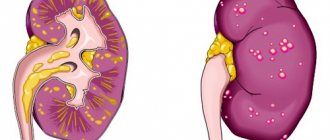Brucellosis (lat. Brucellosis, son. - Bang's disease, Maltese fever, Mediterranean fever, Gibraltar fever, Cyprus fever, Crimean fever, undulating / undulating fever, shaking fever, English Fist of mercy - “fist of mercy”, “five-dollar disease” etc.) is an infectious zoonotic disease with a tendency to have a long course, accompanied by fever, allergization, damage to the mononuclear phagocyte system (MPS), vascular, nervous, reproductive and other systems with particularly frequent involvement of the musculoskeletal system in the pathological process.
Story
Since ancient times, people have known about a long-term illness, accompanied by fever, damage to the joints, and which was observed on the islands and in the Mediterranean countries. In 1859, J. Marston, an English military surgeon, described a special type of undulating fever that often occurred among English soldiers serving in Malta. Having examined the organs of those who died from typhoid fever and those who died from this fever, he drew attention to the morphological differences that arise in these diseases. This allowed Marston to express his opinion about the existence of an independent disease, first called “Mediterranean gastric relapsing fever” and later “Maltese fever”. During the Crimean War, English military doctors most likely observed brucellosis in English troops under the name “Crimean fever”. The causative agent of brucellosis was first isolated from the corpses of dead English soldiers in Malta in 1886 by the English doctor David Bruce, to which he gave the name Micrococcus melitensis. However, it took another 20 years to clarify the source of infection, the method and factors of transmission of this pathogen. The data of the commission, which worked under the direct supervision of D. Bruce in 1904-1907, were published. And she discovered that goats were completely infected with micrococci on the island. Malta and the contamination of all products obtained from these animals (fresh and sour milk, feta cheese, cheese). It was noticed that when goats were brought from pastures in the evening, they were immediately milked in front of the doors of houses on the street and people drank fresh milk. The ban on the consumption of goat milk products without prior heat treatment has led to a sharp decrease in the incidence of brucellosis in Malta. In 1895, in Copenhagen, the Danish veterinarian and bacteriologist B. Bang isolated another pathogen from the amniotic fluid of cows that had miscarriages, which he named Bacillus abortus. Bang proved the connection between infection with this pathogen and abortions in cows, as well as the contagiousness of the infected material. For a long time, these two pathogens occupied independent places in the nomenclature of microorganisms, and B. abortus was not associated with human pathology. However, in 1918. The works of the American microbiologist E. Evans were published, which pointed out the similarities between Micrococcus melitensis and Bacillus abortus. This allowed the researcher to conclude that B. abortus, like micrococcus, can cause pathology not only in animals (cattle), but also in humans. This assumption was convincingly proven in 1924 by C. Kiefer, who isolated B. abortus from the blood of a sick person. In 1914, J. Traum discovered the causative agent of pig abortion - Vast. abortus suis. Later, the pathogenicity of this pathogen for humans was proven. Thus, data was obtained that made it possible in 1928 to combine all three pathogens into a single genus - Brucella (in honor of D. Bruce), identifying 3 separate species pathogenic for humans - Br.melitensis, Br. abortus, Br. suis. Further research showed that this information about Brucella is far from complete: in 1953, Br. ovis - from sheep in 1957 — Br. neotomae - from a representative of the rodent subfamily Neotoma lepida, which in the United States is traditionally called desert tree rats, in 1966. — Br. canis - from hound dogs, in particular, fled in 1994. — Br. network and in 1997 Br. pinnipedialis - from marine mammals. Recently, 2 more Brucella were discovered: Br. microti in the common vole Microtus arvalis (in 2008) and Br. inopinata in humans (2010)
What is this disease?
Considering the type of microbe that caused the development of the pathological process, the International Classification of Diseases ICD-10 proposes the following coding principle:
| A 23.0 | Pathology that occurs when infected with Brucella melitensis (carriers of the infection include goats and sheep). |
| A 23.1 A 23.2 | Brucellosis caused by Brucella suis, Brucella abortus (both bacteria live in the body of pigs). |
| A 23.3 | Disease caused by Brucella canis (transmitted to humans from dogs). |
Codes A 23.8 and A 23.9 indicate other forms of the disease, including brucellosis of unspecified origin.
The disease refers to a zoonotic infection, the pathogens of which are capable of parasitizing the body of an animal or human and using the body of the “host” as a natural reservoir for their habitat. The disease was first discovered in 1859 in Malta, and for some time was called “Maltese fever.” Later, in 1886, the British scientist D. Bruce managed to isolate the pathogenic bacteria (Brucella), which were later named after him.
Cases of brucellosis are recorded all over the world, but most often the disease occurs in countries actively involved in livestock production, among people of working age (from 18 to 55 years). Many experts consider this pathology as an occupational disease of farmers, shepherds, livestock specialists, veterinarians, and meat processing workers.
Brucellosis in humans is characterized by a tendency to become chronic and inability to be transmitted from sick individuals to healthy ones. The causative agents of the disease are common gram-negative bacteria, similar to each other, easily growing in various nutrient media.
Brucella is intolerant to high temperatures and dies at temperatures of 60 degrees or more. At the same time, these microbes show sufficient resistance to low temperatures. While in a living body, bacteria release endotoxin, a substance that leads to the development of severe complications and general weakening of the patient.
relevance
This is one of the most common zoonoses in the world - only 17 countries (in particular Canada, Ireland) reported to WHO that brucellosis is absent on their territory. About 500,000 cases of brucellosis in humans are reported annually worldwide. The problem of brucellosis has remained relevant to agriculture and healthcare for many years. The high sensitivity to brucellosis of almost all farm animals and the ease of infection make it difficult to control this infection among them. The socio-economic significance of the problem of brucellosis is determined by the characteristics of the course of this infection, as well as by the main contingent that is affected, namely the working population, which is associated with both professional factors and social reasons. One of the most striking clinical features of modern brucellosis is the presence of a pronounced tendency for the disease to become chronic with subsequent disability. Polymorphism of clinical manifestations, especially in the early stages, makes timely diagnosis difficult. The problem of treating brucellosis has not yet been solved, since the causative agent of the disease is an intracellular parasite, which makes it inaccessible to the action of antibacterial agents precisely during its stay in the cell. The challenge of creating a reliable and safe vaccine remains. And all this can serve as a basis for using Brucella as a bacteriological weapon.
Preventive measures
To avoid the development of a pathological process, its prevention
.
It consists of following certain simple rules. A person is strictly prohibited from eating
unpasteurized dairy products. Agricultural workers must wear gloves at all times.
Any person is recommended to constantly adhere to the rules of personal hygiene. If a person works in the agricultural sector, then he needs to regularly clean his hands with solutions with antiseptic properties.
Most often, bleach and Creolin solution are used for this purpose. In order to eliminate parasites, it is necessary to keep the food for half an hour at a temperature of 60 degrees.
Note!
A fairly important preventive measure is animal vaccination.
This ensures the elimination of the pathological process by almost one hundred percent.
For vaccination, live weakened bacteria are used, which leads to the development of resistance to bacteria by the animal’s immune system. If the vaccine enters the human body, it can lead to the development of the disease.
etiology
The causative agents of brucellosis belong to the genus Brucella. The genus has several types:
- Br. melitensis,
- Br. abortus
- Br. suis,
- Br. canis
- Br. ovis,
- Br. neotomae,
- Br. pinnipedialis,
- Br. networks,
- Br. inopinata,
- Br. microti.
Brucella are gram-negative bacteria, small in size, characterized by high polymorphism. In one preparation you can see both rod-shaped and coca variants; they do not form spores, are immobile, and belong to intracellular parasites. They grow on many artificial nutrient media, but grow very slowly (3 weeks or more). Many laboratory animals (guinea pigs, white rats, mice) are highly sensitive to Brucella. They are characterized by significant variability and the ability to move from the S-form to the R- and L-forms. Resistant to external influences. They are stored in water for more than 2 months, in cheese - 2 months, in wool - up to 4 months. They quickly die in an acidic environment, when boiled and under the influence of disinfectants. Sensitive to antibiotics of the tetracycline group, streptomycin, rifampicin, fluoroquinolones, macrolides.
Types of disease
There are several forms
pathological process according to which symptoms appear in a person. They are characterized by the same incubation period. Subsequently, the symptoms of the disease differ.
In acute form of the disease
chills, increased body temperature, sweating, and soreness in the muscle area are observed. In pathology, enlargement of the liver and spleen, as well as lymph nodes, is diagnosed. Regardless of the fact that there is a fever, patients do not complain of poor health. The average duration of the pathology is 6 months.
During the course of subacute brucellosis
all of the above signs are present. The patient also experiences the appearance of focal lesions that are of allergic origin. Arthritis, plexitis, neuritis and other diseases can often be found in patients. During pathology, an increase in sensitization is recommended. With this pathological process, the immune system is rebuilt.
, chronic brucellosis develops.
. With this disease, the appearance of fever, which has various types, can be diagnosed. During palpation of soft tissues, small compactions are diagnosed, which are characterized by pain. Chronic brucellosis is accompanied by enlarged lymph nodes.
Brucellosis is a serious pathology that has several types. In accordance with it, a treatment regimen is developed.
Epidemiology
Source and reservoir of infection
Depending on the pathogen, there are different sources of infection when a person is infected:
- Br. melitensis - sheep and goats.
- Br. abortus - cattle.
- Br. suis - pigs.
- Br. canis - dogs.
- Br. pinnipediae - cetaceans.
- Br. ceti - sea pinnipeds.
It is not yet clear the source of infection for Br. inopinata. For another 3 species of Brucella (Br. Ovis, Br. Neotomae, Br. Microti), pathogenicity for humans has not yet been established.
The main source of infection for humans are small and large livestock, as well as pigs. The most characteristic clinical sign of brucellosis in farm animals is abortion. The fetus, membranes, and amniotic fluid contain the causative agent of brucellosis in huge quantities. In animals that have had an abortion, Brucella can be detected in pathological discharge from the birth canal, milk, urine and feces up to 15 months. With secretions, pathogens get outside, contaminating bedding, food, water in watering places, where other animals become infected, and contributes to the occurrence of epizootic outbreaks. A sick person does not pose a danger to others.
Mechanism and factors of transmission
Infection of people occurs through a contact mechanism involving direct contact, household and nutritional routes. Infection by contact especially often occurs when amniotic fluid comes into contact with the skin (during calving assistance, when caring for newborn calves, lambs). Infection can also occur during the processing of raw meat, skin, and wool of animals with brucellosis. Brucella penetrates through the slightest damage to the skin. Raw dairy products, sheep cheese, kumiss, etc. are dangerous. Milk is the cause of infection for many people who are not professionally involved in animal husbandry. In this case, infection occurs through the mucous membrane of the oropharynx, and not the stomach and intestines, since gastric juice has a detrimental effect on Brucella.
Susceptible contingent and immunity
Precisely because infection is not significant in the spread of brucellosis in the human population, this pathology is not classified as a disease with natural focality, but as a regional pathology, since it occurs mainly in regions with livestock-oriented agriculture. Thus, human economic activity and its specificity (small or large livestock, pig farming) leave an imprint on the formation of cells with the predominant spread of a certain type of brucellosis pathogens.
The highest incidence is observed among people who have close contact with animals sick with brucellosis (shepherds, shepherds, veterinarians, livestock workers), workers in meat processing plants, and enterprises where wool is processed. In most cases, human brucellosis is an occupational disease. Infection is possible in laboratories where they work with live Brucella cultures. Due to the frequent chronicity of the disease, there is no talk about immunity, which protects, in brucellosis.
Symptoms of the disease
The incubation period of the disease ranges from 7 days to several weeks. Most often, signs of Brucella infection appear during the first 14 days. Each stage of the disease is characterized by its own distinctive features.
Subacute stage of brucellosis
In the subacute stage, the symptoms of brucellosis take the form:
- slight increase in body temperature (up to 37-37.5 °C);
- chills;
- pulling muscle pain;
- loss of appetite;
- thirst, dry mouth;
- headaches of varying intensity;
- weakness, irritability;
- insomnia.
The pathology quickly moves into the acute stage. This may take several days.
Acute stage of the disease
This stage provokes negative reactions of the body - the appearance of joint pain, mainly affecting the lower extremities, swelling of the lymph nodes, and an increase in body temperature to 38-40 degrees. An infected person is characterized by profuse sweating, which increases at night, paresthesia (numbness) of the arms or legs, and allergic skin rashes.
The progression of brucellosis leads to the development of other diseases. So the patient may experience tonsillitis, bronchitis, pneumonia, myocarditis, meningitis, thrombophlebitis, keratitis. In men, the likelihood of developing prostatitis and epididymitis (inflammation of the testicular appendages) increases. The female body exhibits signs of endometritis (inflammation of the uterine mucosa), salpingitis (disease of the fallopian tubes), oophoritis (inflammatory disease of the ovaries). In representatives of both sexes, activation of Brucella increases the likelihood of developing intercostal neuralgia, hearing or vision impairment.
Chronic and residual forms of the disease
Chronic pathology leads to damage to the musculoskeletal system. Patients with prolonged brucellosis develop difficult to treat diseases - arthritis, bursitis, radiculitis, polyarthritis.
A special form of the disease is residual brucellosis, in which the pathogen is often not detected. Despite this, pathological processes associated with disturbances in the functioning of the immune and nervous systems still occur in the body.
At this stage of the disease, patients experience persistent low-grade fever (constantly increased body temperature to 37-37.3 degrees), joint deformities requiring a full-fledged operation, and damage to other organs and tissues.
pathogenesis
Once in the human body, Brucella does not cause any significant changes at the site of introduction. The first phase of regional infection, when Brucella reaches the lymph nodes through the lymphatic tract, corresponds to the incubation period. Reproduction and accumulation of Brucella occurs mainly in the lymph nodes. In acute brucellosis, clinical manifestations correspond to primary bacteremia (hematogenous introduction). Subacute brucellosis is characterized by repeated and multiple bacteremia with symptoms of sensitization. With the bloodstream, the pathogen enters the organs of the SSF (liver, spleen, bone marrow), where new foci of infection are formed with the pathogen re-entering the blood, causing fever and general infectious syndrome. In chronic brucellosis, the pathogen enters various organs and systems (central nervous system, reproductive system, musculoskeletal system). Brucellosis is characterized by allergic restructuring of the body, pronounced hypersensitivity of type ΙV/delayed type, which persists for a long time even after cleansing the body of the pathogen. It should be noted that the transition of acute brucellosis to chronic is not at all necessary, and also with the development of chronic brucellosis it is not at all necessary to have a preliminary stage of acute brucellosis. The duration of the disease with brucellosis does not exceed 2-3 years. Subsequently, as a result of sclerotic changes in organs and tissues, consequences are observed (residual brucellosis). A long relapsing course over many years is associated with reinfection. The manifestations of the disease are significantly influenced by the type of Brucella that caused the disease. The heavy move is associated with Br. melitensis. Br. abortus, Br. Suis, Br. canis cause cases that are generally of moderate severity, but often also asymptomatic. In humans, only isolated cases of the disease due to infection with Br have been described. pinnipedialis and Br. networks with a predominance of lesions of the nervous system. Br. inopinata is known to cause infection in a 71-year-old woman with a breast implant.
Morphology of brucellosis
Morphological changes in brucellosis are polymorphic. They mainly manifest themselves in the connective tissue of various organs; their nature and severity depend on the phase of development of the pathological process. In the acute phase, exudative-inflammatory changes of a serous nature occur in the lymph nodes and internal organs (liver, spleen). Infectious-reactive vasculitis occurs. In the subacute and chronic phases of the process, productive-inflammatory changes predominate with the formation of specific brucellosis granulomas, mainly in the musculoskeletal, nervous and reproductive systems.
Brucellosis - what is it?
Brucellosis is a systemic zoonotic infectious disease, characterized by a variety of transmission mechanisms and accompanied by the development of febrile syndrome, polyarthritis, myositis, bone deformities, as well as damage to the nervous and reproductive systems. The disease code according to ICD10 is A23.
For reference. The source and carrier of the disease are domesticated animals. Wild animals are also susceptible to brucellosis, but there are no natural foci of infection.
Brucellosis is the causative agent
Brucellosis is caused by bacteria of the genus Brucella from the family Brucellaceae. Brucella are intracellular parasites capable of producing endotoxins (bacterial toxins). Due to the presence of the enzyme hyaluronidase, bacteria are able to break down the hyaluronic acid contained in the connective tissue and quickly spread in organs and tissues.
Brucellosis in humans is caused by 4 main types of bacteria:
- melitensis (the most common cause of brucellosis in humans. The main hosts of this type of Brucella are sheep and goats;
- abortus (the source of infection are cows and bulls);
- suis (pigs serve as reservoirs for Brucella);
- canis (the source of the disease is dogs).
The causative agent of brucellosis is resistant to environmental influences. When hitting:
- fresh water, brucella can persist for more than two months;
- milk – about forty days;
- feta cheese – more than two months;
- hard cheeses – up to a year;
- raw meat - more than three months, salted meat stores viable brucella for about a month;
- animal hair – about four months.
Important. Brucella is resistant to low temperatures, but they die instantly during boiling (therefore, it is impossible to become infected by consuming thermally processed meat products or boiled milk).
The pathogen is also highly sensitive to various disinfectants and some antibiotics:
- tetracyclines,
- aminoglycosides,
- rifampicin,
- erythromycin.
Brucellosis - transmission routes
Brucellosis is part of a group of zoonotic diseases (transmitted from animals to humans). Infection occurs through contact with sick animals, inhalation of bacteria in the air (working with skins, down, etc.), and consumption of products infected with bacteria (meat, milk, cheeses, etc.).
Attention. Alimentary brucellosis in humans is most often associated with the consumption of dairy products that have not undergone heat treatment. Meat can cause infection if it has been salted or frozen (stroganina), or insufficiently heat-treated (kebab or rare steak). Infection from drinking water is extremely rare.
Contact infection is most often carried by Prof.
character. Usually people who work as shepherds, milkmaids, veterinarians, livestock specialists, etc. suffer from brucellosis. The entry gates for Brucella can be the mucous membranes of the conjunctiva, respiratory and gastrointestinal tracts, as well as the skin (in the presence of microtraumas).
Infection can occur during:
- animal haircuts,
- combing fur or fluff,
- processing of hides,
- cleaning the premises where animals are kept (bacteria are released into the environment along with the excrement of a sick animal).
Important. A sick person does not pose an epidemiological danger and cannot serve as a source of infection. The exception is pregnant women (transmission from mother to fetus) and breastfeeding women, since Brucella can pass into breast milk, leading to infection of the baby during feeding.
Brucellosis mainly affects people from 20 to 50 years of age. Immunity after the disease is not strained; after five years, re-infection is possible.
Clinical manifestations
Brucellosis is characterized by polymorphism of clinical manifestations. Therefore, many clinical classifications have been proposed. According to ICD-10 there are:
- brucellosis, which is caused by Br. melitensis (A25.0)
- brucellosis, which is caused by Br. abortus (A25.1)
- brucellosis, which is caused by Br. suis (A25.2)
- brucellosis, which is caused by Br. canis (A25.3)
- other forms of brucellosis (A25.8)
- brucellosis, unspecified (A25.9)
Brucellosis is often classified clinically: subclinical, acute, subacute, chronic, residual.
subclinical course
The patients are in satisfactory condition. Upon careful examination, mild enlargement of the peripheral lymph nodes may be detected in some individuals. This course is often characteristic of brucellosis, which is caused by Br. abortus.
Acute variant of the course
Develops after an incubation period lasting from 1 week to 2 months. The disease begins with an increase in body temperature to high numbers. This course is typical for brucellosis, which is caused by Br. melitensis. The temperature curve can be of various types: undulating, remitting, and occasionally constant. Some patients have low-grade fever. An increase in body temperature is accompanied by chills and severe sweating. Sweating (up to profuse sweats) and chills (from mild to severe chills) are more pronounced the more significant the changes in body temperature are (they are clearly recorded when body temperature is measured every 3 hours). The severity of the triad of symptoms - fever, chills and sweating - significantly correlates with the severity of brucellosis. It is characteristic that even if the patient has a high fever, his general condition is better than what happens with other infections (influenza, typhoid fever, epidemic typhus, etc.). Patients tolerate high body temperature satisfactorily, one might even say relatively “well”. There are no other signs of intoxication. By the end of the first week, an increase in the liver and spleen is noted. Generalized lymphadenopathy is formed - the lymph nodes are moderately enlarged, often the size of a large pea (hence the name “polymicroadenitis” with their generalized enlargement), some of them are sensitive to palpation. The main feature at this stage is the absence of clear focal changes in the organs. Acute brucellosis can occasionally result in recovery, but as a rule it becomes subacute and chronic. In case of recovery from an acute course, complete release from the pathogen occurs; residual effects usually do not have time to form, but sensitization to Brucella antigens persists for a long time. Therefore, repeated infection (reinfection) can lead to the return of manifestations of the disease, but with earlier formation of focal lesions.
Subacute variant of the course
In addition to moderate symptoms of intoxication, attacks of moderate fever, focal lesions appear in the form of arthritis, plexitis, neuritis, lesions of the gonads, etc. A characteristic early lesion of the musculoskeletal system is considered to be a pathological process in the sacroiliac joints. Asymmetrical arthritis of other joints is possible. Most often, neuritis of the sciatic nerve occurs. Neuritis and plexitis are also characterized by asymmetrical lesions. Very often, lesions of the reproductive system occur - orchitis (inflammation of the testicles), epididymitis, adnexitis.
Chronic course
In some cases, it develops immediately, bypassing the acute phase, in other cases, signs of chronic brucellosis appear some time after the acute onset. Chronic brucellosis is characterized by the involvement of more and more new organs and systems in the pathological process. The longer the course of chronic brucellosis, the more varied the clinical manifestations and complaints of patients are. During the next exacerbation, new metastatic foci may appear, accompanied by the appearance of new symptoms against the background of old ones. Characteristic changes in periods of exacerbations and remissions are common, and there are complaints from patients: headache, weakness, fatigue, dyspepsia, heaviness in the right hypochondrium, joint pain, discomfort in the heart, poor sleep, and the like. Patients are often restless, “sticky” in direct contact. The variety of complaints often tires not only the doctor working with the patient, but also the patient’s loved ones. Body temperature is often low-grade or absent for weeks and months (remission). Patients note increased irritability, depressive symptoms, poor sleep, asthenia, and decreased performance. Even deep-lying lymph nodes (mediastinum, mesenteric) may be enlarged. With enlargement of the mesenteric lymph nodes, patients complain of pain along the intestine. With damage to the nerve plexuses (solaritis) - pain in the epigastric region.
Damage to the musculoskeletal system
It is the most common manifestation of chronic brucellosis. Patients complain of pain in muscles and joints. Myositis develops. During palpation, painful areas are often found in the muscles of the limbs, and compactions are felt in the thickness of the muscles. In the lumbosacral region, in the hip area and in other areas, nodules or cords can be detected in the subcutaneous tissue upon palpation. These are so-called fibrositis (dystrophic and incendiary changes in the structure of fibrous connective tissue) mainly around the joints, as well as in the lumbar, sacral, and gluteal areas. The sizes of fibrositis vary - from a pea to a bean; in some patients, fibrositis has a diameter of 5 to 10 cm. Cellulite also occurs mainly in the tissues of the extremities. The density and size of these formations can vary depending on the severity and duration of the process.
With brucellosis, very rarely only one joint is involved in the pathological process. Large joints (knees, hips, shoulders, ankles) are mainly affected. The function of the joints is limited due to pain, but the configuration changes little. Typical for brucellosis and bursitis, most often of the elbow joints, tendovaginitis, arthrosis-arthritis. Gradually, patients may develop ankylosis and contractures. Movements in the joints cause pain, are severely limited or completely absent; joints are enlarged and deformed. The most typical are lesions of the iliosacral joints (sacroiliitis) and the spine. The diagnostic value of sacroiliitis is very high, since other etiological agents cause them extremely rarely. There are a number of diagnostic techniques to identify sacroiliitis. The Eriksen symptom is informative, the essence of which is that the patient is placed on a dressing table on his back or side and the iliac crest is pressed when lying on his side, or the anterior superior crests of the iliac bones are compressed with both hands in a supine position. With unilateral sacroiliitis, pain occurs on the affected side, with bilateral sacroiliitis, patients note pain on both sides. The Nakhlas symptom is also used, in which the patient is placed on a table with his stomach down and his legs are bent at the knee joint. When lifting a limb, pain appears in the affected iliosacral joint. The John-Ber symptom turns out to be like this: the patient is in a supine position, with pressure on the pubic joints perpendicularly downward, pain appears in the iliosacral joint.
Damage to the nervous and mental sphere
When the peripheral nervous system is damaged, radiculitis, neuritis, and the autonomic nervous system appear in the form of adynamia and sweating. Of the cranial nerves, the I, III, VI, VII pairs are most often involved in the process. Rarely, but possible development of meningitis, meningoencephalitis with typical symptoms.
In some cases, patients have mental disorders. Liquid brucellosis psychoses last a long time, with exacerbations.
Damage to the cardiovascular system
Vasculitis, myocarditis, endocarditis occur, and rarely, cardiac arrhythmias.
Damage to the genital organs
Men experience orchitis, epididymitis, and decreased sexual function. Orchitis is more often unilateral, accompanied by severe pain and enlargement of the organ. In women - adnexitis, endometritis (inflammatory processes in the endometrium. Premature birth, abortion, development of infertility are possible. At the same time, it should be noted that women suffering from brucellosis can become pregnant and give birth to completely healthy children. Children during childbirth and while breastfeeding have brucellosis DO NOT get infected.
eye damage
They are rare and develop iritis, chorioretinitis, uveitis, keratitis, etc.
residual brucellosis
In the clinical picture of the consequences of brucellosis, complaints of increased fatigue, weakness, and irritability come to the fore. Patients note low-grade fever, sleep disturbances, memory loss, increased sweating, vascular disorders - cold extremities, ease of bruising. Inflammatory changes in the joints and surrounding tissues lead to the development of arthrosis, ankylosis of the joints with their deformation and dysfunction. In the spine, sclerosis of the intervertebral discs occurs, followed by compression of the nerve roots and the formation of persistent radicular pain. Deformation of the vertebrae occurs due to the development of osteoporosis, the formation of osteophytes. For many years after the activity of the process has subsided, patients are bothered by pain in the muscles, joints and spine, which intensifies when the weather changes. Against the background of hypothalamic/diencephalic syndrome, progression of mental disorders (obsessiveness, phenomena of depersonalization and derealization, hallucinations, etc.) is possible. Adhesive arachnoiditis forms, which sometimes causes severe headaches and attacks. Defeat n. opticus can lead to blindness. Inflammatory processes in the genital area of men often cause infertility, impotence, and in women - permanent miscarriage and infertility. At this stage, the pathogen is no longer in the patient’s body.
Brucellosis - symptoms in humans
The incubation period of brucellosis in humans ranges from one to six weeks (usually up to three weeks). In some cases, the incubation period can increase to several months (with latent onset). Symptoms of brucellosis in humans develop gradually and depend on the clinical form of the disease:
- primary latent brucellosis;
- acute septic;
- metastatic;
- secondary latent.
Attention. With primary latent brucellosis, the infected person's peripheral lymph nodes become enlarged, low-grade fever is noted, and sweating increases. The general condition is slightly disturbed, patients retain their working capacity and, as a rule, do not even consider themselves sick.
With the acute septic onset of brucellosis, a person experiences high undulating fever (up to 40 degrees), profuse sweating and chills. Signs of general intoxication practically do not appear, the patient’s state of health remains relatively satisfactory.
There is also an increase in lymph nodes (in all groups), liver and spleen (hepatolienal syndrome is noted towards the end of the first 1st disease). Enlarged lymph nodes are painless or slightly painful on palpation.
Acute septic forms are characterized by a favorable course and the absence of the formation of distant metastatic foci of infection. The acute septic form is not sepsis and, as a rule, does not pose a threat to the patient’s life.
Patients with brucellosis may also experience:
- insomnia;
- increased irritability, emotional lability, depressive states, mania;
- serous meningitis;
- pain and aches in muscles and joints;
- redness of the neck and face against a background of pale torso and limbs;
- joint stiffness;
- severe arterial hypotension, heart rhythm disturbances;
- symptoms of myocarditis, endocarditis, pericarditis;
- Men may experience symptoms of orchitis and epididymitis.
diagnostics
bacteriological method
The causative agent of brucellosis in acute and subacute forms can be isolated from blood, bone marrow and other biosubstrates by inoculating on artificial nutrient media. However, bacteriological research methods are complex and require special conditions, including increased protection of laboratory workers. Brucella grows slowly, over the course of a month.
serological method
In terms of serological reactions, the most informative is the agglutination reaction, which is performed in 2 modifications - the Wright reaction, carried out in a test tube, and the Guddleson reaction, which is carried out on a glass slide and is taken into account in qualitative terms (+ pluses). In the acute version of brucellosis, antibodies begin to appear in the second week of the disease and subsequently their titer increases. A titer of at least 1:200 (Wright reaction) and at least 2+ (Huddleson reaction) is considered diagnostic. More sensitive for diagnosis are the complement fixation reaction and indirect hemagglutination, which can differentiate the disease from post-vaccination changes. In the world, blood tests for antibodies of different classes are also widely used in ELISA and PCR.
allergological method
Allergological methods for diagnosing brucellosis use the Burnet test by intradermal injection of brucellin (filtrate of a three-day broth culture of Br. Melitensis). The reaction is taken into account by the size of the edema (with a diameter of less than 1 cm - the reaction is considered doubtful, with 1-3 cm - weakly positive; more than 3 cm - positive). An intradermal test, as a rule, becomes positive by the end of the first month of the disease. It should be taken into account that performing an allergy test can lead to the appearance of antibodies or an increase in antibody titer. The reaction does not allow one to determine the degree of activity of the process, but only indicates infection, without specifying its timing. It can also be positive in vaccinated people. Negative Burnet test results exclude brucellosis. Sometimes patients who have undergone the Burnet test experience an exacerbation of the disease. The big disadvantage of this test is that it can affect the results of subsequent serological studies, which is why it is more often used in epidemiological surveys of the population than in clinical practice.
Symptoms of brucellosis
The incubation period usually lasts 1–3 weeks, but can last up to 5 months.
In the acute form , the onset of the disease is, accordingly, acute and pronounced:
- temperature increase;
- sweating, weakness;
- headache;
- loss of appetite;
- pain in joints, muscles, lower back;
- excitement, euphoria, insomnia;
- increase in all groups of lymph nodes;
- the appearance in the subcutaneous tissue and muscles of inflammatory nodules - painful dense areas, up to a chicken egg in diameter.
Without antibiotic therapy, a high fever can persist for up to a month.
As the disease progresses, symptoms of joint inflammation come to the fore: pain, swelling, impaired mobility and function. Damage to other systems gradually develops.
From the nervous system:
- increased sweating,
- unstable blood pressure,
- headache,
- heart rate slowdown,
- radiculitis, plexitis (inflammation of nerve roots and plexuses),
- neuritis and atrophy of the optic and auditory nerves,
- meningitis, meningoencephalitis,
- depression,
- manic state,
- chronic psychoses.
From the cardiovascular system:
- endocarditis (inflammation of the inner lining and valves of the heart),
- myocarditis (inflammation of the heart muscle).
From the genital area:
- orchitis, epididymitis (inflammation of the testicles and epididymis);
- salpingoophoritis (inflammation of the ovaries and fallopian tubes);
- endometritis (inflammation of the inner lining of the uterus);
- spontaneous abortions (miscarriages), premature birth.
From the liver:
- chronic hepatitis,
- liver abscesses.
From the respiratory system:
- pneumonia,
- bronchopneumonia,
- pleurisy.
From the hematopoietic system:
- thrombocytopenia (decreased platelet count);
- hemorrhages.
As you can see, the manifestations of the disease are varied and can affect almost any organ. With residual, long-term brucellosis, irreversible changes in various organs and systems gradually accumulate: persistent joint contractures, cicatricial changes in the nerve plexuses, changes in the neuropsychic sphere.
treatment
Therapy depends on the form of the disease. In acute forms of brucellosis, it is necessary to prescribe antibiotics in fairly high course doses. Insufficient doses and premature discontinuation of drugs cause further development of chronic brucellosis. WHO now recommends the simultaneous use of doxycycline 0.1 g per day in adults in combination with rifampicin 0.6-0.9 g per day for 6 weeks. It is possible to use doxycycline 0.1 g per day for 6 weeks together with streptomycin 1 g per day intramuscularly for 2-3 weeks. This latter option of antibiotic therapy is considered more effective in preventing relapse. In this option, it is possible to replace doxycycline with ciprofloxacin, or streptomycin with gentamicin or amikacin in appropriate doses. Complex therapy for brucellosis does not exclude relapses of the disease. Relapses often occur after 7-8 months, and sometimes after 1-2 years after the course of treatment.
A variety of pathogenetic therapy is also prescribed: detoxification, anti-inflammatory drugs. For severe inflammatory changes (orchitis, neuritis, etc.), glucocorticoids are prescribed for 2-3 weeks.
To treat subacute as well as chronic brucellosis during relapse, vaccination can be used, combined with treatment with antibiotics and other drugs. The most effective intravenous method of vaccine therapy. For the first time, 250,000 microbial bodies of the vaccine are administered intravenously and the patient is monitored for 6:00, taking into account his reactions. With a moderately expressed reaction, which has a healing value, a course of vaccine therapy is started. If a shock reaction occurs, then this therapy is abandoned. The first therapeutic dose of the vaccine should be 500,000, then 1000000, 3000000, 5000000, 10000000, 25000000, 50000000 are administered at intervals of 3-4 days and finish with a dose of 75000000 microbes per injection; a total of 8 intravenous infusions of the vaccine are given. In many countries around the world, vaccination for brucellosis is considered inappropriate.
In chronic forms, the prescription of antibiotics is justified only in the presence of fever. The most effective vaccine therapy, which not only has a desensitizing effect, but also stimulates immunogenesis. To stimulate the body's resistance, methyluracil, sodium nucleinate, etc. are used, physiotherapy, electrophoresis, paraffin baths, therapeutic exercises, therapeutic massage, hydrogen sulfide and radon baths, and mud therapy are performed.
Disease prognosis and prevention
If the disease is diagnosed on time and the correct treatment is prescribed, the prognosis for life and health is favorable. However, with various complications (for example, disorders of the musculoskeletal system), there is a risk of the patient developing disability.
As for prevention, in this case, it includes a certain set of measures, the purpose of which is to reduce the number of people with brucellosis. It is necessary to monitor the health of livestock, compliance with favorable sanitary and hygienic living conditions, consumption of high-quality dairy products, and proper storage of meat and milk.
Routine vaccination of both domestic and wild livestock is required. The use of live brucellosis vaccine is indicated for those who have direct contact with animals. Those who work with food must undergo a medical examination every year and observe personal hygiene rules. In addition to all these rules, it is necessary to monitor the condition of your livestock (goats, sheep, wild boars, pigs, etc.).
If you notice changes in the behavior of animals (for example, refusal to eat or aggression for no reason), you must immediately call a veterinarian or take the animal to the first reception point for further examination and treatment.
prevention
Prevention consists primarily of eliminating infection among farm animals and disinfecting the environment. In areas where brucellosis occurs in livestock, disinfection of products and raw materials of animal origin becomes of great importance. Milk from cows and goats can only be consumed after boiling or pasteurization. All dairy products must be made from pasteurized milk. The basis of prevention should be a set of sanitary and veterinary measures. When working with sick animals, use protective clothing and disinfectants.
Vaccination with special vaccines plays a significant role in preventing the spread of brucellosis among animals. There is a live anti-tibrucellosis vaccine. However, immunization with a live vaccine provides only short-term immunity. The vaccine based on the 19 B. abortus strain is used exclusively for vaccination of farm animals. A person should be treated with great caution before receiving live anti-brucellosis vaccines. Vaccinated people often complained of deterioration in health, manifested by arthralgia, neuralgia, and lymphadenopathy. Currently, scientists are working on the development of chemical and inactivated corpuscular vaccines against brucellosis.
Symptoms of infection
- Increased body temperature. Temperature changes occur in waves. In a third of patients, brucellosis occurs without fever or with a slight deviation from the norm.
- Growth of lymph nodes. First of all, with brucellosis, regional lymph nodes increase in volume. Increasing in number, bacteria begin to accumulate in peripheral lymph nodes.
- If the musculoskeletal system is affected - muscle and joint pain, swelling of the joints, bone growth, limited mobility and the appearance of painful, subcutaneous lumps.
- If the nervous system is damaged - deterioration of vision and hearing, intercostal neuralgia, plexitis, meningitis, myelitis and decreased sensitivity of nerve endings.
- If the genitourinary system is affected - orchitis, epididymitis, menstrual irregularities, endometritis, spontaneous abortion.
Brucellosis in animals
In infected animals, brucellosis can be asymptomatic, although quite often it becomes chronic, and the pathogen can persist in the body for months and years and is excreted in milk and urine (most often this happens when infected with Br. Abortus). In goats, the infection occurs predominantly with expressive clinical manifestations. In terms of the frequency of development of manifest forms in infected animals, pigs occupy an intermediate place. One of the most typical (and sometimes the only) manifestations of brucellosis in animals is spontaneous abortion, which often results in barrenness, mastitis, and in males, orchitis. The spread of infection among animals occurs mainly through milk (when feeding calves) and sexually. In animals with manifest or subclinical forms of brucellosis, the pathogen is found in the blood, milk, urine, and after they are bruised, it persists for a long time in meat products and on wool. In animals, complete self-healing occurs in most cases.
In dogs Br. canis are transmitted through pregnancy and contact with aborted fetuses. Brucella in dogs usually infects the reproductive and lymphatic systems, eyes, kidneys, and intervertebral discs. Damage to the intervertebral disc is one of the causes of discospondylosis in dogs. Clinical manifestations of burcellosis in dogs include abortion in females and inflammation of the scrotum with orchitis in males. Fever is rare. Infection of the eyes can lead to uveitis.
In addition to pets Br. abortus also infects bison and moose in North America, Br. suis - caribou. Brucella Br. pinnipediae and Br. ceti have been isolated from several species of marine mammals (pinnipeds and cetaceans).
Causes of brucellosis
The causative agents of the disease are bacteria from the genus Brucella. Four species are dangerous to humans: B. Melitensis, B. Abortus, B. Suis, B. Canis. The pathogen is able to penetrate through intact mucous membranes. It is highly stable in the external environment: dry heat at a temperature of 90–95 degrees kills it within an hour, in a humid environment at a temperature of 60 degrees it dies in half an hour, and when boiled, it dies instantly. At low temperatures, the bacterium remains viable for months. It can survive for quite a long time in food: up to 10 days in raw milk (if stored in the refrigerator), up to 2 weeks in fermented milk products and meat, in cheese and butter - more than a month. Viable bacteria can survive in sheep wool for up to 4 months.
Most often, the source of infection is cattle, goats and sheep, and pigs, but some species can be carried by hares, deer, mouse-like rodents, and even dogs. People usually become infected through direct contact with animals, processing animal raw materials, or consuming contaminated products, especially unboiled cow's milk. Cases of transmission of the disease by airborne means - during cleaning of barnyards and processing of wool - are extremely rare. It is also extremely rare that the disease is transmitted from person to person, although there are known cases of infection through blood transfusions and sexual contact.
Bacteria accumulate in the lymph nodes, causing allergic changes in the body. After reaching a certain amount, they enter the blood (this period coincides with the first symptoms of the disease), spreading throughout the body and forming inflammatory foci. Due to allergic restructuring, the immune system, as a rule, is not able to cope with the infection, and the disease becomes chronic, either subsiding or worsening. An exacerbation can be caused by any factor that reduces the body's defenses: hypothermia, overwork, stress, viral infections.
Brucella as a bioweapon
Research in the 19th century showed the prospect of using Brucella as a bioweapon. The ability of Brucella to survive makes it possible for them to be transported in shells and bombs over long distances. But, for example, in the USA they quickly abandoned the use of brucella in biological warfare due to their weak ability to cause rapid death of the affected person (the estimated lethality was kept at 3%, death occurred three months after the defeat), because the doctrine of biological warfare of this country required lethal weapons The retained infective dose ranges from 300 to 500 microorganisms for humans, depending on the type of Brucella. In general, in 1972, the bioweapons development program in the United States was discontinued.
Microbiology and routes of infection
Brucella are aerobic gram-negative coccobacilli that have the unique ability to penetrate both cells and survive in the intracellular environment.
The microorganism can enter the human body through defects in the skin, mucous membranes, conjunctiva, respiratory and gastrointestinal tracts.
Inside the body in the blood, foreign microorganisms affect protective processes against viruses and bacteria, as a result of numerous mechanisms of influence on immune cells, they end up inside protective cells - polymorphonuclear cells and macrophages. Evidence suggests that the lipopolysaccharide coating of microbes plays an important role in their survival, possibly due to the synthesis of adenine and guanine monophosphate.
In addition, many bacterial species have relatively low virulence, toxicity, and pyrogenicity, making them weak inducers of some inflammatory cytokines such as tumor necrosis factor and interferons. Microbiology believes that they suppress programmed cell death (apoptosis).
Brucella that survive are transported to the lymphatic system and may divide locally and replicate in the kidneys, liver, spleen, mammary glands, or joints, causing infection. Any complex of organs may be involved (eg, central nervous system, heart, joints, genitourinary system, pulmonary system, or skin).
The development of cellular immunity is the main mechanism of recovery. IgM levels initially increase, followed by IgG titers. Persistently elevated IgG concentrations usually indicate chronic or recurrent infection.
emedicine.medscape.com
Treatment regimen
The choice of medications depends largely on whether a person has certain symptoms. Treatment of brucellosis in humans must be comprehensive. Antibiotics such as Doxycycline, Rifampicin, Streptomycin and Gentamicin are used to fight infection.
Statistics show that such drugs give a good effect only in laboratory conditions. In practice, only complex antibacterial therapy helps. For example, patients are often prescribed simultaneous use of Doxycycline and Streptomycin. Treatment with antibiotics lasts about 4-6 weeks.
If bacterial endocarditis occurs, a third antibiotic may be added to the treatment regimen. Of course, such aggressive therapy cannot but affect the functioning of the entire body. That is why patients are recommended to take pre- and probiotics (for example, Bifiform, Linex), as well as medications to protect liver cells (Essentiale).
Symptomatic treatment is also carried out. For example, analgesics are used to relieve pain. Nonsteroidal anti-inflammatory drugs help control fever. For severe joint pain, patients are prescribed special ointments that eliminate pain and relieve swelling.
Corticosteroids are used extremely rarely for this disease. Most often they are introduced into the treatment regimen in the presence of meningitis and other inflammatory lesions of certain structures of the nervous system.
Vaccination
To this day, brucellosis remains a serious problem for healthcare and rural residents. For this serious disease, the main target population is the working-age rural population. The disease is caused directly by occupational factors. In these cases, vaccination against brucellosis in humans is strongly recommended.
The most striking clinical feature of a harmful disease is the transformation of brucellosis into a chronic stage with subsequent human disability. Therefore, it is recommended to carry out scheduled vaccinations against brucellosis for the population.
First of all, a preventive vaccine against brucellosis for humans is carried out in disadvantaged areas, and especially where microscopic organisms of brucella have been found in small livestock. All employees of livestock farms, cheese factories, meat processing plants and regardless of how long they work there are vaccinated.
Families raising their own cattle are also vaccinated. If there are children over seven years old, they are also vaccinated. Immunization is also carried out for laboratory employees who conduct experiments with live harmful microorganisms, and for workers of zootechnical and veterinary services.
When vaccinated, a person is given a live brucella vaccine from a cow strain. When the first preventive vaccinations were made in the middle of the last century, the injections were administered purely subcutaneously. Since 1958 During immunization, live concentrated Brucella vaccine was used in dry form.
Artificially created immunity lasts a short time. After immunization, the highest tension is observed at 2-3 months, and then in 30% of vaccinated people it gradually declines. After about a year, the protection completely disappears.
In the current epidemic, previously vaccinated patients may become infected with the virus again if they have a weakened immune system. For the epidemiological effectiveness of the vaccine to work, it is recommended to give injections a couple of months before the start of the calving and lambing season.
Clinical contraindications to immunization:
- A person who has a positive reaction to an immunological test is not vaccinated against brucellosis;
- Do not give injections to pregnant and lactating women;
- Persons who have previously had brucellosis;
- Persons who have identified clinical primary symptoms of this disease.
Stages and symptoms
This disease most often has hidden symptoms that are difficult to diagnose in the early stages. Every livestock breeder should be wary of repeated abortions in cows and the birth of non-viable calves.
The appearance of such signs should be a reason to contact a veterinary clinic with a mandatory referral for examination of the placenta, aborted fetus or colostrum samples.
Read more: White Zembla chrysanthemum - home care, photos, mix.
The external signs of the disease are most pronounced in cows - after a miscarriage caused by Brucella, an inflammatory process begins in the cow’s uterus, which also affects her fallopian tubes, as a result of which the animal becomes temporarily infertile, but if the inflammation is not removed in a timely manner, this process is irreversible.
At the same time, sick cows experience loss of appetite, lethargy, a sharp increase in body temperature, pain in the limbs and inflammatory processes in the joints - bursitis and arthritis are formed.
After some time, cows are diagnosed with tendovaginitis and hygromas, and bulls are diagnosed with swelling of the testes, numerous inflammatory processes in the prostate gland and appendages, as well as subcutaneous abscesses with signs of necrosis.
Did you know? The most expensive meat is marbled beef, which is obtained from Wagyu cows. Every day, each representative of this breed is fed with selected herbs, given the purest water and beer, and before bed, each cow receives a relaxing massage.
Acute
This period lasts 30–60 days. It is characterized by a sharp increase in body temperature. External manifestations of brucellosis at this stage are difficult to notice with the naked eye, however, when examining the internal organs, the veterinarian may notice an enlargement of the liver and spleen.
At the end of the acute stage, enlarged lymph nodes, especially pelvic ones, may be noticeable, and inflammatory processes in the genital organs begin. If the animal has a strong immune system, then the infection can proceed completely unnoticed, and after a while the brucellae disappear from their blood without a trace.
Subacute
The subacute stage has a longer period of 60–90 days. It is characterized by wave-like manifestations of the disease - a sharp deterioration in the well-being of animals is replaced by improvement. But, despite this, it is already possible to diagnose the external manifestations of brucellosis - inflammation of the joints, subcutaneous abscesses and brown discharge from the genitals.
Chronic
This stage of brucellosis is characterized by the manifestation of external signs of the disease for three or more months. Sick animals lose their appetite, become lethargic and nervous. Symptoms of the disease become visible to the naked eye - inflammation of the joints, blood discharge from the genitals, subcutaneous tumors. Constant pain in the limbs makes cows restless.
Important! Symptoms of brucellosis are in many ways similar to other dangerous diseases, for example, tuberculosis, salmonellosis and leptospirosis, therefore, when prescribing treatment, you should only rely on the results of several clinical studies.
Symptoms and diagnosis of the disease
Early symptoms of brucellosis in humans are:
- Sleep disturbance.
- General malaise.
- Brokenness.
- Muscle pain.
- Temperature increase. Fever persists for several days. The maximum duration of the febrile period is 3 weeks.
- Loss of appetite.
- Emotional instability.
- Chill with profuse sweat.
- Redness and swelling of the face.
- Enlarged cervical and axillary lymph nodes.
- Signs of cellulite.
- Fall in blood pressure.
- Headache.
Later, signs of damage to various organs are observed in the form of pain in the right hypochondrium, swelling of the joints, neurological symptoms, rapid heartbeat, chest pain, a feeling of interruptions in the functioning of the heart muscle, cyanosis of the skin, pain along the veins (observed with thrombophlebitis), nausea, vomiting, disturbances of consciousness and sensitivity, numbness.
Sometimes with brucellosis, the genitals are involved in the process. In this case, redness and swelling of the scrotum, pain in the groin, and dysuria in the form of painful urination are observed. The subacute form of the disease often occurs with rashes, thirst, constipation and fever. The chronic course is characterized by a wave-like character. Symptoms of intoxication are moderate or mild. The temperature is most often low-grade.
With brucellosis the following may develop:
- arthritis,
- spondylitis (inflammation of the spine),
- inflammatory diseases of the female genital organs,
- orchitis (inflammation of the male reproductive glands),
- epididymitis (inflammation of the epididymis),
- prostatitis,
- inflammation of the fascia and muscle aponeuroses,
- neuritis,
- radiculitis,
- paresis,
- neuropathy,
- contractures,
- amyotrophy,
- inflammation of the bursae and tendons,
- endocarditis,
- damage to the pericardial sac,
- thrombophlebitis,
- angina,
- bronchitis,
- inflammation of the pharynx,
- pneumonia,
- hepatitis,
- arrhythmia,
- inflammation of the membranes and substance of the brain,
- inflammatory eye diseases (keratitis, uveitis),
- optic nerve atrophy,
- infertility.
This disease can complicate the course of pregnancy and lead to miscarriage. If you have symptoms of brucellosis, you should consult a doctor. To make a diagnosis you will need:
- anamnesis collection,
- physical examination,
- serological analysis,
- bacteriological culture,
- cerebrospinal fluid examination,
- general and biochemical blood tests (leukocytosis, increased monocytes, decreased neutrophils, accelerated ESR are detected),
- Burnet skin test,
- Ultrasound of internal organs,
- X-ray (informative for joint damage),
- CT or MRI,
- ECG,
- electroencephalography,
- Dopplerography (if there are symptoms of thrombophlebitis).
Differential diagnosis is carried out with malaria, HIV infection and lymphogranulomatosis.
What symptoms accompany the subacute form?
At this stage, the clinical picture changes:
- Fever is still present, but is often interspersed with periods of relative well-being when the patient's body temperature drops to normal levels.
- Against the background of a sharp increase in temperature, short-term disturbances in heart rhythm are often observed.
- There are other symptoms indicating the presence of an inflammatory process. Patients complain of chills, severe pain in the joints and muscles, increased heart rate, extreme thirst, and a feeling of goosebumps on the skin. Symptoms also include constipation and dry mouth.
- Through the skin along the muscles and tendons, small dense formations the size of a pea can be felt.
- Patients complain of stiffness in movement, joint pain, and swelling in the affected areas. Against the background of infection, diseases such as polyarthritis, bursitis, and tendovaginitis (inflammatory lesions of the ligaments) develop.
- In men, bacteria often penetrate the tissues of the testicles and appendages. The inflammatory process in this case is accompanied by severe swelling of the scrotum, pain in the groin area, lower abdomen and lower back.
- The woman's reproductive system is also sensitive to this type of infection. The activity of pathogenic microorganisms is often accompanied by menstrual irregularities and the development of endometritis.
In the most severe cases, the disease is accompanied by inflammation of the lining of the heart (pericarditis). There is a possibility of developing infectious-toxic shock.
Diagnosis of brucellosis
In accordance with the “Federal standards of medical care for the diagnosis of brucellosis,” the following examination standards are used: general blood test, urine test (twice over time), feces for worm eggs, biochemical blood test (bilirubin concentration, ALT, AST activity), blood test for Brucellae spp., blood test for Wright's reaction, Heddleson's reaction, RPHA with brucellosis erythrocyte diagnosticum, Coombs' reaction (twice in dynamics), Burnet's test, ECG, ultrasound of internal organs, radiography of the spine, joints, consultation with an ophthalmologist, neurologist (if indicated ).
When diagnosing brucellosis, epidemiological prerequisites are taken into account. In many areas of central and southwestern Russia, brucellosis in animals has long been eliminated - therefore, there are no conditions for infecting people. In these regions, brucellosis is an “imported” infection. It is necessary to clarify your stay in places where brucellosis is still encountered. But sometimes infection occurs through products infected with Brucella (homemade cheese, milk, etc.).
Laboratory confirmation of brucellosis is limited, since Brucella is a dangerous pathogen. Their isolation can only be carried out in special laboratories equipped in accordance with the requirements of prevention. During serological and allergological studies, it is necessary to take into account that those vaccinated against brucellosis (vaccinated by risk groups who have professional contact with animals) may have positive results of both serological reactions and especially allergy tests for quite a long time.
Of the serological reactions, the most informative is RA (Wright's reaction). Slide agglutination (Heddleson reaction) is not used for diagnosis. It is proposed to identify persons subject to examination for brucellosis during mass surveys for epidemiological reasons. The Heddleson test often produces false positive results. To a certain extent, this is due to cross-reactions with a number of antigens (Yersinia, the causative agent of tularemia, cholera vaccination, etc.). It should be taken into account that B. melitensis and B. abortus have cross-reactions with each other, but not with B. canis, so to detect antibodies to this brucella, a special diagnostic kit is needed, which is not yet available. Perhaps this is one of the reasons that this type of brucellosis is rarely detected.
In the acute septic form of brucellosis, antibodies can be detected in the 2nd week of illness, and subsequently their titer increases. The allergy test becomes positive at the end of the first and 2nd week. In chronic forms, an increase in antibody titer is often not detected. It should be borne in mind that performing an allergy test (Burnet test) can provoke the appearance of antibodies or an increase in their titer. Other serological reactions: RPHA, acute phase reactions are less informative compared to the Wright reaction and are not significant. In recent years, a more sensitive ELISA method has been used to determine IgG and IgM antibodies. Negative results of the Burnet test make it possible to exclude brucellosis (except for HIV-infected people, in whom all HRT reactions disappear).
Differential diagnosis of brucellosis
Varies significantly depending on the form of brucellosis. The acute septic form should be differentiated from many diseases accompanied by high fever. The main difference between brucellosis is that patients feel satisfactory at a temperature of 39–40 °C, although in some diseases (lymphogranulomatosis, tuberculosis) the state can also remain satisfactory at high temperatures. These diseases are characterized by organ damage: a significant increase in any group of lymph nodes, changes in the lungs.
In the acute septic form of brucellosis, there are no focal organ lesions (metastases), only the liver and spleen are enlarged, and there are no changes in the blood (Fig. 17-1).
It is more difficult to differentiate chronic forms of brucellosis. Their peculiarity is damage to the joints, and therefore they should be differentiated from many diseases characterized by arthritis. Acute arthritis can appear in many acute infectious diseases (pseudotuberculosis, yersiniosis, mumps, rubella, scarlet fever, etc.). In such cases, diagnosis is facilitated by the presence of symptoms characteristic of a particular infectious disease.
More severe purulent damage to joints is observed in sepsis and generalized forms of a number of diseases (glanders, melioidosis, listeriosis). The difference between these diseases is the severe condition of the patients, while patients with brucellosis feel satisfactory. Monoarthritis of large joints is a consequence of gonorrhea or chlamydia (in combination with urethritis and other manifestations of these diseases). Brucellosis is the only infectious disease in which chronic polyarthritis develops, so it must be differentiated from polyarthritis of other etiologies: rheumatoid arthritis, systemic lupus erythematosus, systemic scleroderma, psoriatic arthritis, sarcoidosis. They can be distinguished from brucellosis by a set of clinical signs that are not characteristic of brucellosis. A set of appropriate laboratory and instrumental studies is also carried out to exclude these diseases (Fig. 17-2).
Rice. 17-1. Algorithm for differential diagnosis of acute septic form of brucellosis.
Fig.17-2. Algorithm for differential diagnosis of chronic brucellosis.
Indications for consultation with other specialists
For visceral forms of brucellosis with damage to the cardiovascular system, consult a cardiologist; for urogenital forms, consult a urologist or obstetrician-gynecologist.
Approximate formulation of diagnosis
A23.9. Chronic brucellosis, combined form (locomotor + urogenital), stage of subcompensation.
Home remedies
It’s worth saying right away that any independent measures and traditional medicine can only be used with the permission of a doctor. Brucellosis is a dangerous disease that, if treated incorrectly, can lead to dangerous consequences, including disability and death.
- It is believed that regular mineral water baths have a positive effect on the state of the nervous system and musculoskeletal system. Experts recommend periodically visiting sanatoriums and not giving up special massages and mud applications, as this helps restore joint mobility.
- At home, it is recommended to add a decoction of pine needles to bathing water - this product has calming properties and has a beneficial effect on the functioning of the respiratory and cardiovascular systems.
- You can also prepare a medicine for internal use. To do this, you need to mix a tablespoon of black elderberry flowers, stinging nettle leaves, and bean pods. All ingredients must be crushed and mixed thoroughly. Pour a tablespoon of the mixture into two glasses of boiling water, cover with a lid and let it brew. The strained liquid should be consumed four times a day, half a glass.
- You can relieve inflammation and activate the immune system with the help of another herbal mixture. You will need four spoons of birch leaves, five spoons of willow bark, a tablespoon of alder buckthorn leaves. To prepare the medicine, pour 500 ml of boiling water into three large spoons of the herbal mixture, then heat over low heat for 20 minutes. After the broth has cooled, it can be strained. Herbalists recommend taking a glass of medicine every two hours (it needs to be warmed up first, you can sweeten it a little).
- Fresh juices will also help improve the functioning of the body. In order to prepare a tasty and healthy medicine, you need to mix 750 ml of carrot and 350 ml of pumpkin juice. Mix these ingredients and take half a glass of the medicine three times a day, preferably before meals.
Of course, such drugs cannot replace full-fledged antibacterial therapy - these are only auxiliary means that help speed up the body’s recovery process.
What drugs are used to treat brucellosis?
- Doxycycline - 0.1 g per day for 6 weeks in combination with rifampicin or streptomycin;
- Rifampicin - 0.6-0.9 g per day for 6 weeks;
- Streptomycin - 1 g per day intramuscularly for 2-3 weeks;
- Ciprofloxacin - as an alternative to doxycycline (in combination with streptomycin).
When should a person be tested for brucellosis?
A referral for a general blood test and bacteriological tests will be given by an infectious disease doctor as soon as he detects clear signs of the development of brucellosis. Tests to identify the causative agents of brucellosis in their pure form are carried out only in specially equipped laboratories.
IMPORTANT: The material for bacteriological research can be: blood, urine, bile, bone marrow or joint fluid of the patient.
A test for brucellosis is prescribed by the attending physician.
Treating brucellosis at home
Treatment of brucellosis at home is inferior in effectiveness to measures used in a hospital. Therefore, the acute form of brucellosis requires hospitalization; relapse or chronic brucellosis can be treated at home, but under the close supervision of a physician, and if necessary, outpatient treatment, visits to clinics, and special infectious diseases departments are indicated. Under no circumstances should you self-medicate, adjust the dosages of medications prescribed by the doctor, or change the duration of the course of treatment.
Prevention of brucellosis is aimed at reducing the incidence among farm animals. The basis of prevention should be a set of sanitary and veterinary measures. When working with sick animals, use protective clothing and disinfectants.
A live anti-brucellosis vaccine has been developed, but immunization with this vaccine provides only short-term immunity. A vaccine based on the Bg strain. abortus is used exclusively for vaccination of farm animals. The administration of a live anti-brucellosis vaccine to a person should be treated with great caution, since after vaccination, patients often complain of deterioration in health, which is manifested by arthralgia, neuralgia, and lymphadenopathy. Today, scientists are working on the creation of chemical and inactivated corpuscular vaccines against brucellosis.
Vaccine against brucellosis
There are currently no vaccinations to prevent the disease in humans. At the same time, a vaccine has been developed for use in cattle, which indirectly reduces the risks and morbidity in humans.
Brucella abortus causes disease in cattle. A special strain of microorganism developed for a live vaccine is able to provide a significant immune response during the development of infection.
Accidental exposure of a person to the vaccine leads to the development of symptoms consistent with brucellosis. Other vaccines work similarly in people.
www.cdc.gov
Case history of brucellosis
The history of brucellosis begins in the 19th century. Only the name of this disease sounded like Malta fever. In the 1850s, English doctors first encountered this disease on the island of Malta during the Crimean War. The discovery of the disease for the scientific world was made by Geoffrey Allen Marston in 1861. An interesting fact is that he described his own illness.
The cause-and-effect relationship between bacteria and the body was established in 1887 by David Bruce. David classified the bacterium that causes brucellosis as a cocci. In 1897, Danish veterinarian Bernhard Bang discovered a rod-shaped bacterium that can cause spontaneous abortion in cows. This disease is called Bang's disease. At that time, no one knew that it was the same disease.
The fact that “Maltese fever” and “Bang disease” were the same disease only came to light in the late 1910s. This discovery was made by American bacteriologist Alice Evans. Evans, while studying Bang's bacillus, noticed that it was no different from Bruce's coccus. Having established that this was the same bacterium, she began to look for similar cases of diseases in the United States. The number of correctly undiagnosed diseases with such symptoms was very large. This event was a breakthrough in bacteriology. Also because of this discovery, significant changes occurred in the dairy industry. These include stricter sanitary standards when collecting milk and the use of pasteurization. Many at the top of the dairy industry were against these measures due to the significantly increased costs, but over time they became the norm.
Over the next decades, several subspecies of this bacterium were discovered. Which were later combined into the genus brucella, and the disease was renamed brucellosis in honor of David Bruce.
Read: Diphtheria as a disease that kills 5,000 people a year
Mechanism of spread of infection
As a rule, brucellosis in cattle occurs when 10 bacteria enter the cow's body. Among the routes of infection, one can distinguish various microtraumas, mucous membranes, and, above all, the oral cavity and respiratory tract. Cows that have miscarried are especially dangerous. Brucella is found in large quantities in amniotic fluid and the placenta. A stillborn calf is also infected. Spread through common feeding troughs, watering holes, bedding and care items is highly likely.
Brucella is found in the meat and milk of sick animals, so eating them without pre-treatment can be dangerous for humans. Also, through the smallest cuts and abrasions on the skin, representatives of professions who have direct contact with cattle can become infected. For example, milkmaids, shepherds, veterinarians, workers in slaughterhouses, meat processing plants and dairy production.
The bacterium does not survive in the open air, so aerogenic spread is excluded. A person can become infected with brucellosis from a person through direct contact of microtraumatized areas of the skin (handshakes) or mucous membranes (kissing).
Brucellosis bacteria resist the effects of the external environment well. In unpasteurized dairy products, bacteria live for more than 50 days, in frozen meat of a sick cow they persist for at least 5 months, in hides and fur - about 3 months.
A reservoir can be cleared of Brucella within six months, while soil can be cleared of Brucella within at least 2 years.
You can get rid of brucellosis infection by heating the contaminated environment or treating it with disinfectants for 10 minutes. The latter method is only suitable for tools and animal habitats.
Is it possible to eat meat and milk from cows infected with brucellosis? The answer is clear - you can, but with caution. To eat, the meat of a sick individual should be boiled for 3-4 hours, and the milk should be boiled for 10-15 minutes.
Most often, the source of infection is a sick cow that was allowed into the herd without a preliminary veterinary examination. The spread of bacteria occurs through urine, feces, amniotic fluid, blood, and animal semen.
Brucella enters the body through wounds, mucous membranes, and also after consuming contaminated water or feed. It should be noted that if the cow has a strong immune system and the dose of pathogenic microorganisms is small, then the animal’s body gets rid of the virus without any consequences.
Pathogenic microorganisms first attack the lymphatic system of animals - at this stage, timely treatment in most cases gives a positive result. Brucella then enters the bloodstream and begins to infect the internal organs of the cow. Foci of inflammation form in the kidneys, liver, pancreas and lungs, which cause various disturbances in the functioning of these organs.
After the end of the acute stage of the disease, Brucella concentrates in the lymph nodes (the largest number is in the pelvic lymph nodes), uterus, udder and spleen.
Effective disease prevention
Preventive measures aimed at preventing the development of brucellosis include the following:
- avoiding consumption of unprocessed dairy products and meat;
- compliance with safety rules by agricultural workers, in particular, the use of disposable gloves cannot be ignored;
- timely vaccination of pets.
In addition, a person in contact with an animal that is infected with brucellosis must be observed by medical workers for six months.











